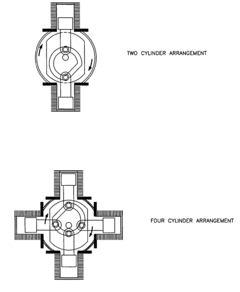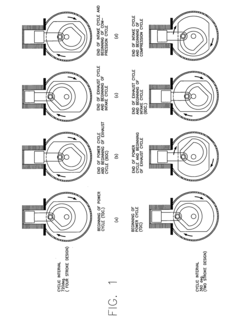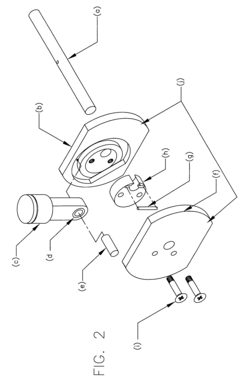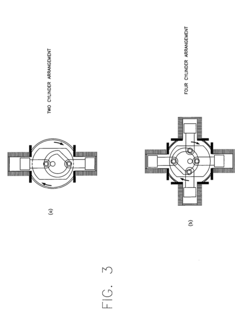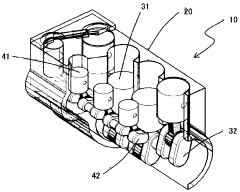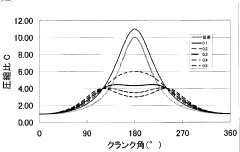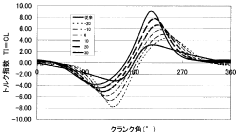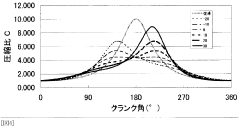How V8 Engines Improve Torque: A Mechanical Study?
JUL 4, 20259 MIN READ
Generate Your Research Report Instantly with AI Agent
Patsnap Eureka helps you evaluate technical feasibility & market potential.
V8 Engine Evolution
The V8 engine has undergone significant evolution since its inception in the early 20th century. Initially developed to provide more power and smoother operation than inline engines, V8s have become synonymous with high-performance vehicles and heavy-duty applications. The evolution of V8 engines can be traced through several key phases, each marked by technological advancements and design improvements.
In the early stages, V8 engines were primarily focused on increasing displacement to generate more power. This era saw the introduction of larger bore sizes and longer strokes, resulting in engines with massive cubic inch displacements. However, these early V8s were often inefficient and lacked refinement in terms of fuel economy and emissions.
The mid-20th century brought about a shift towards performance optimization. Engineers began to focus on improving combustion efficiency, valve timing, and intake/exhaust flow. This period saw the widespread adoption of overhead valve (OHV) designs, which allowed for better airflow and higher compression ratios. The introduction of high-performance camshafts and multi-barrel carburetors further enhanced power output and throttle response.
As environmental concerns grew in the latter part of the 20th century, V8 engine development shifted towards improving fuel efficiency and reducing emissions. This led to the introduction of electronic fuel injection systems, which provided more precise fuel metering and improved overall engine management. Additionally, variable valve timing technologies were implemented to optimize engine performance across a wider range of operating conditions.
The turn of the 21st century marked a new era in V8 engine evolution, characterized by the integration of advanced materials and manufacturing techniques. Lightweight alloys and composite materials began to replace traditional cast iron components, reducing overall engine weight while maintaining strength. Computer-aided design and simulation tools allowed engineers to optimize engine geometries for improved combustion efficiency and reduced friction losses.
Recent developments in V8 engine technology have focused on hybridization and electrification. Many modern V8 engines now incorporate cylinder deactivation systems, allowing them to operate as smaller displacement engines under light load conditions for improved fuel economy. Some manufacturers have also introduced mild hybrid systems, integrating electric motors to provide additional torque and further enhance efficiency.
The latest advancements in V8 engine design have centered around maximizing power density while meeting increasingly stringent emissions regulations. This has led to the widespread adoption of direct fuel injection, turbocharging, and advanced thermal management systems. These technologies allow modern V8 engines to produce unprecedented levels of power and torque from relatively small displacements, while still meeting strict environmental standards.
In the early stages, V8 engines were primarily focused on increasing displacement to generate more power. This era saw the introduction of larger bore sizes and longer strokes, resulting in engines with massive cubic inch displacements. However, these early V8s were often inefficient and lacked refinement in terms of fuel economy and emissions.
The mid-20th century brought about a shift towards performance optimization. Engineers began to focus on improving combustion efficiency, valve timing, and intake/exhaust flow. This period saw the widespread adoption of overhead valve (OHV) designs, which allowed for better airflow and higher compression ratios. The introduction of high-performance camshafts and multi-barrel carburetors further enhanced power output and throttle response.
As environmental concerns grew in the latter part of the 20th century, V8 engine development shifted towards improving fuel efficiency and reducing emissions. This led to the introduction of electronic fuel injection systems, which provided more precise fuel metering and improved overall engine management. Additionally, variable valve timing technologies were implemented to optimize engine performance across a wider range of operating conditions.
The turn of the 21st century marked a new era in V8 engine evolution, characterized by the integration of advanced materials and manufacturing techniques. Lightweight alloys and composite materials began to replace traditional cast iron components, reducing overall engine weight while maintaining strength. Computer-aided design and simulation tools allowed engineers to optimize engine geometries for improved combustion efficiency and reduced friction losses.
Recent developments in V8 engine technology have focused on hybridization and electrification. Many modern V8 engines now incorporate cylinder deactivation systems, allowing them to operate as smaller displacement engines under light load conditions for improved fuel economy. Some manufacturers have also introduced mild hybrid systems, integrating electric motors to provide additional torque and further enhance efficiency.
The latest advancements in V8 engine design have centered around maximizing power density while meeting increasingly stringent emissions regulations. This has led to the widespread adoption of direct fuel injection, turbocharging, and advanced thermal management systems. These technologies allow modern V8 engines to produce unprecedented levels of power and torque from relatively small displacements, while still meeting strict environmental standards.
Torque Demand Analysis
The demand for increased torque in V8 engines has been driven by several factors in the automotive industry. Primarily, the need for improved performance in both passenger vehicles and heavy-duty applications has pushed manufacturers to develop more powerful and efficient engines. In passenger cars, particularly in the luxury and sports segments, consumers expect rapid acceleration and high-speed capabilities, which directly correlate with engine torque output. For heavy-duty vehicles, such as trucks and construction equipment, higher torque is essential for towing, hauling, and operating under challenging conditions.
Market trends indicate a growing preference for vehicles with enhanced towing capacity and payload capabilities, especially in North America and Europe. This demand has led to a continuous increase in torque requirements for V8 engines. Additionally, the rise of electric and hybrid vehicles has put pressure on traditional internal combustion engines to improve their performance to remain competitive. As a result, manufacturers have been compelled to innovate and enhance the torque output of V8 engines to meet these evolving market demands.
The automotive industry has also seen a shift towards downsizing engines while maintaining or improving performance. This trend has led to the development of turbocharged V8 engines, which can produce higher torque at lower RPMs compared to naturally aspirated counterparts. The focus on fuel efficiency and emissions regulations has further intensified the need for engines that can deliver high torque with improved fuel economy.
In the commercial vehicle sector, the demand for increased torque in V8 engines is driven by the need for better fuel efficiency and reduced operating costs. Higher torque allows for more efficient operation at lower engine speeds, which can significantly reduce fuel consumption in long-haul transportation. This economic benefit has become a crucial factor for fleet operators and individual truck owners alike.
The racing and high-performance vehicle markets have also contributed to the demand for increased torque in V8 engines. These sectors continually push the boundaries of engine performance, requiring innovative solutions to extract maximum power and torque from V8 configurations. The advancements made in these high-stress environments often trickle down to consumer vehicles, driving overall improvements in V8 engine torque across various applications.
Market trends indicate a growing preference for vehicles with enhanced towing capacity and payload capabilities, especially in North America and Europe. This demand has led to a continuous increase in torque requirements for V8 engines. Additionally, the rise of electric and hybrid vehicles has put pressure on traditional internal combustion engines to improve their performance to remain competitive. As a result, manufacturers have been compelled to innovate and enhance the torque output of V8 engines to meet these evolving market demands.
The automotive industry has also seen a shift towards downsizing engines while maintaining or improving performance. This trend has led to the development of turbocharged V8 engines, which can produce higher torque at lower RPMs compared to naturally aspirated counterparts. The focus on fuel efficiency and emissions regulations has further intensified the need for engines that can deliver high torque with improved fuel economy.
In the commercial vehicle sector, the demand for increased torque in V8 engines is driven by the need for better fuel efficiency and reduced operating costs. Higher torque allows for more efficient operation at lower engine speeds, which can significantly reduce fuel consumption in long-haul transportation. This economic benefit has become a crucial factor for fleet operators and individual truck owners alike.
The racing and high-performance vehicle markets have also contributed to the demand for increased torque in V8 engines. These sectors continually push the boundaries of engine performance, requiring innovative solutions to extract maximum power and torque from V8 configurations. The advancements made in these high-stress environments often trickle down to consumer vehicles, driving overall improvements in V8 engine torque across various applications.
V8 Torque Challenges
V8 engines, renowned for their power and performance, face several challenges in optimizing torque output. One of the primary issues is the inherent design limitation of the V-configuration, which can lead to uneven power delivery across the engine's rotation. This unevenness can result in vibrations and reduced efficiency, particularly at lower RPMs where torque is most crucial.
Another significant challenge is the balance between high-end power and low-end torque. V8 engines are often designed to produce impressive horsepower figures, which can sometimes come at the expense of low-end torque. This trade-off can affect the engine's responsiveness and acceleration from a standstill, particularly in heavier vehicles or those used for towing.
Heat management presents another hurdle in V8 torque optimization. The compact design of V8 engines, while beneficial for packaging, can lead to increased heat generation. Excessive heat can negatively impact engine performance, reducing torque output and potentially causing long-term reliability issues. Engineers must devise effective cooling solutions without compromising the engine's compact nature or adding excessive weight.
Fuel efficiency is an ongoing concern, especially given the increasing focus on environmental regulations. V8 engines are traditionally known for their high fuel consumption, which can be at odds with the need for improved torque. Balancing these competing demands requires innovative approaches to engine design and fuel management systems.
The complexity of modern V8 engines also presents challenges in torque optimization. Advanced technologies such as variable valve timing, direct injection, and turbocharging, while beneficial for overall performance, add layers of complexity to engine management. Coordinating these systems to work harmoniously for optimal torque production across various operating conditions is a significant engineering challenge.
Emissions regulations pose another significant hurdle. Stricter environmental standards require V8 engines to produce cleaner exhaust, which can potentially impact torque output. Engineers must find ways to meet these regulations without sacrificing the power and torque characteristics that V8 engines are known for.
Lastly, the weight of V8 engines themselves can be a limiting factor in torque optimization. Heavier engines require more power to overcome their own inertia, potentially reducing the amount of torque available for vehicle propulsion. This challenge necessitates the exploration of lighter materials and more efficient designs to maximize the torque-to-weight ratio.
Another significant challenge is the balance between high-end power and low-end torque. V8 engines are often designed to produce impressive horsepower figures, which can sometimes come at the expense of low-end torque. This trade-off can affect the engine's responsiveness and acceleration from a standstill, particularly in heavier vehicles or those used for towing.
Heat management presents another hurdle in V8 torque optimization. The compact design of V8 engines, while beneficial for packaging, can lead to increased heat generation. Excessive heat can negatively impact engine performance, reducing torque output and potentially causing long-term reliability issues. Engineers must devise effective cooling solutions without compromising the engine's compact nature or adding excessive weight.
Fuel efficiency is an ongoing concern, especially given the increasing focus on environmental regulations. V8 engines are traditionally known for their high fuel consumption, which can be at odds with the need for improved torque. Balancing these competing demands requires innovative approaches to engine design and fuel management systems.
The complexity of modern V8 engines also presents challenges in torque optimization. Advanced technologies such as variable valve timing, direct injection, and turbocharging, while beneficial for overall performance, add layers of complexity to engine management. Coordinating these systems to work harmoniously for optimal torque production across various operating conditions is a significant engineering challenge.
Emissions regulations pose another significant hurdle. Stricter environmental standards require V8 engines to produce cleaner exhaust, which can potentially impact torque output. Engineers must find ways to meet these regulations without sacrificing the power and torque characteristics that V8 engines are known for.
Lastly, the weight of V8 engines themselves can be a limiting factor in torque optimization. Heavier engines require more power to overcome their own inertia, potentially reducing the amount of torque available for vehicle propulsion. This challenge necessitates the exploration of lighter materials and more efficient designs to maximize the torque-to-weight ratio.
Current Torque Solutions
01 Torque measurement and control in V8 engines
Various methods and systems are employed to measure and control torque in V8 engines. These include advanced sensors, electronic control units, and algorithms that analyze engine parameters to optimize torque output and efficiency. Such systems can adjust fuel injection, valve timing, and other factors to maintain optimal torque across different operating conditions.- Torque measurement and control in V8 engines: Various methods and systems are employed to measure and control torque in V8 engines. These include advanced sensors, electronic control units, and algorithms that analyze engine parameters to optimize torque output. Such systems can adjust fuel injection, ignition timing, and valve timing to maintain optimal torque across different operating conditions.
- Improving V8 engine efficiency and performance: Techniques for enhancing V8 engine efficiency and performance focus on optimizing combustion processes, reducing friction, and improving thermal management. These may include advanced materials, cylinder deactivation systems, and variable valve timing mechanisms to balance power output with fuel economy.
- V8 engine torque management in vehicles: Torque management systems in vehicles with V8 engines are designed to enhance drivability, traction control, and overall vehicle dynamics. These systems integrate with transmission control units and stability control systems to optimize power delivery and handling characteristics across various driving conditions.
- Diagnostic and monitoring systems for V8 engine torque: Advanced diagnostic and monitoring systems are developed to assess and predict torque output in V8 engines. These systems utilize real-time data analysis, machine learning algorithms, and predictive maintenance techniques to ensure optimal engine performance and early detection of potential issues affecting torque production.
- Innovative V8 engine designs for torque optimization: Novel V8 engine designs incorporate features specifically aimed at torque optimization. These may include modified cylinder configurations, advanced turbocharging systems, and innovative camshaft designs. Such developments focus on enhancing low-end torque while maintaining high-end power output to suit various applications.
02 V8 engine design for improved torque characteristics
Innovations in V8 engine design focus on enhancing torque characteristics. This includes modifications to cylinder configurations, crankshaft designs, and intake/exhaust systems. Some designs incorporate variable valve timing, cylinder deactivation, or turbocharging to provide better low-end torque and overall performance across a wide RPM range.Expand Specific Solutions03 Torque management systems for V8 engines in vehicles
Advanced torque management systems are developed for V8 engines in various vehicle applications. These systems integrate with transmission control, traction control, and stability systems to optimize torque delivery to the wheels. They can adjust torque output based on driving conditions, vehicle load, and driver input to enhance performance and safety.Expand Specific Solutions04 Diagnostic and monitoring systems for V8 engine torque
Sophisticated diagnostic and monitoring systems are implemented to assess and maintain optimal torque performance in V8 engines. These systems use real-time data analysis, predictive algorithms, and machine learning to detect torque-related issues, optimize engine performance, and schedule preventive maintenance.Expand Specific Solutions05 Torque enhancement technologies for V8 engines
Various technologies are developed to enhance torque output in V8 engines. These include advanced fuel injection systems, forced induction methods like supercharging or turbocharging, and the use of lightweight materials to reduce rotational mass. Some innovations focus on improving combustion efficiency and reducing friction to maximize torque production.Expand Specific Solutions
V8 Engine Manufacturers
The V8 engine technology market is in a mature stage, with a substantial global market size driven by the automotive industry's demand for high-performance engines. Major players like Toyota, Ford, GM, and Hyundai have established strong positions, leveraging their extensive R&D capabilities and manufacturing expertise. The technology's maturity is evident in the widespread adoption across various vehicle segments, from luxury cars to high-performance sports vehicles. Companies such as ZF Friedrichshafen and Bosch contribute significantly to the ecosystem by providing advanced components and systems that enhance V8 engine performance. As environmental concerns grow, there's an increasing focus on improving V8 engine efficiency and exploring hybrid technologies to meet stricter emissions standards.
Toyota Motor Corp.
Technical Solution: Toyota has developed a high-performance V8 engine with D-4S (Direct injection 4-stroke gasoline engine Superior version) technology. This system combines direct and port fuel injection to optimize torque across the entire RPM range. The engine features VVT-iE (Variable Valve Timing-intelligent by Electric motor) on the intake camshaft, which improves low-end torque and high-end power[1]. Toyota's V8 also incorporates a high 11.8:1 compression ratio and an Acoustic Control Induction System (ACIS) that varies the intake tract length based on engine speed and throttle opening[2]. These technologies work together to enhance torque output, especially at lower RPMs, while maintaining fuel efficiency.
Strengths: Advanced fuel injection system improves torque across all RPMs. VVT-iE enhances low-end torque. High compression ratio increases overall engine efficiency. Weaknesses: Complexity of the D-4S system may increase maintenance costs. High compression ratio may require premium fuel.
Ford Global Technologies LLC
Technical Solution: Ford's latest V8 engine technology focuses on improving torque through a combination of advanced features. Their 5.0L Coyote V8 engine incorporates dual overhead camshafts (DOHC) with Twin Independent Variable Camshaft Timing (Ti-VCT), allowing for precise control over valve timing to optimize torque output across the RPM range[3]. The engine also features a high-flow intake manifold and charge motion control valves that improve air-fuel mixture for better combustion efficiency. Ford has implemented Plasma Transferred Wire Arc (PTWA) cylinder liner technology, which reduces friction and allows for a larger bore, contributing to increased torque[4]. Additionally, their port fuel injection system with charge motion control valves enhances low-end torque by creating a more turbulent air-fuel mixture.
Strengths: Ti-VCT system provides excellent torque across a wide RPM range. PTWA technology reduces friction and allows for larger displacement. Charge motion control valves improve low-end torque. Weaknesses: Complexity of the Ti-VCT system may lead to higher maintenance costs. The advanced technologies may result in a higher initial cost for the engine.
Key V8 Torque Patents
Torque improved engine or T.I.E
PatentInactiveUS20060102135A1
Innovation
- The Torque Increased Efficiency (T.I.E.) design modifies the mechanical geometry by incorporating an offset disc that rotates in an orbit around the output shaft axis, increasing leverage during the power stroke with a 45-degree inclination, thereby enhancing torque transmission, while maintaining efficiency during other strokes by reverting to a common radius after 90 degrees rotation.
Two-crank type internal-combustion engine
PatentWO2010001498A1
Innovation
- The integration of an auxiliary cylinder that communicates with the main cylinder at the angle of maximum crank moment arm, with the auxiliary piston positioned to maximize the compression ratio by adjusting its phase relative to the main piston, thereby enhancing crank rotation and torque.
Fuel Efficiency Impact
The impact of V8 engines on fuel efficiency is a complex and multifaceted topic that has evolved significantly over time. Initially, V8 engines were primarily associated with high performance and power output, often at the expense of fuel economy. However, advancements in engine technology have led to substantial improvements in fuel efficiency without compromising the inherent advantages of V8 configurations.
One of the key factors contributing to enhanced fuel efficiency in modern V8 engines is the implementation of cylinder deactivation systems. This technology allows the engine to selectively shut down a portion of its cylinders during low-load conditions, effectively reducing fuel consumption when full power is not required. By operating on fewer cylinders, the engine can maintain optimal efficiency levels, particularly during highway cruising or light urban driving.
Variable valve timing and lift systems have also played a crucial role in improving the fuel efficiency of V8 engines. These systems allow for precise control over valve operation, optimizing air intake and exhaust flow across a wide range of engine speeds and load conditions. This results in improved combustion efficiency, reduced pumping losses, and better overall fuel economy.
Direct fuel injection technology has further enhanced the fuel efficiency of V8 engines. By precisely delivering fuel directly into the combustion chamber, this system allows for more accurate fuel metering and improved mixture formation. The result is a more complete combustion process, leading to increased power output and reduced fuel consumption.
Turbocharging and supercharging technologies have enabled manufacturers to downsize V8 engines while maintaining or even increasing power output. These forced induction systems allow smaller displacement engines to produce comparable power to larger naturally aspirated units, resulting in improved fuel efficiency without sacrificing performance.
Advanced engine management systems and electronic controls have also contributed significantly to fuel efficiency gains in V8 engines. These systems continuously monitor and adjust various engine parameters in real-time, ensuring optimal performance and efficiency across all operating conditions. This includes features such as adaptive learning algorithms and predictive control strategies that further optimize fuel consumption based on driving patterns and conditions.
The integration of start-stop systems in V8-equipped vehicles has provided additional fuel savings, particularly in urban environments. By automatically shutting off the engine during idle periods and quickly restarting it when needed, these systems reduce unnecessary fuel consumption and emissions during frequent stops.
In conclusion, while V8 engines have traditionally been associated with high performance and fuel consumption, technological advancements have significantly improved their fuel efficiency. Through a combination of innovative technologies and sophisticated control systems, modern V8 engines can now deliver impressive power outputs while maintaining competitive fuel economy figures, challenging the notion that high performance and efficiency are mutually exclusive.
One of the key factors contributing to enhanced fuel efficiency in modern V8 engines is the implementation of cylinder deactivation systems. This technology allows the engine to selectively shut down a portion of its cylinders during low-load conditions, effectively reducing fuel consumption when full power is not required. By operating on fewer cylinders, the engine can maintain optimal efficiency levels, particularly during highway cruising or light urban driving.
Variable valve timing and lift systems have also played a crucial role in improving the fuel efficiency of V8 engines. These systems allow for precise control over valve operation, optimizing air intake and exhaust flow across a wide range of engine speeds and load conditions. This results in improved combustion efficiency, reduced pumping losses, and better overall fuel economy.
Direct fuel injection technology has further enhanced the fuel efficiency of V8 engines. By precisely delivering fuel directly into the combustion chamber, this system allows for more accurate fuel metering and improved mixture formation. The result is a more complete combustion process, leading to increased power output and reduced fuel consumption.
Turbocharging and supercharging technologies have enabled manufacturers to downsize V8 engines while maintaining or even increasing power output. These forced induction systems allow smaller displacement engines to produce comparable power to larger naturally aspirated units, resulting in improved fuel efficiency without sacrificing performance.
Advanced engine management systems and electronic controls have also contributed significantly to fuel efficiency gains in V8 engines. These systems continuously monitor and adjust various engine parameters in real-time, ensuring optimal performance and efficiency across all operating conditions. This includes features such as adaptive learning algorithms and predictive control strategies that further optimize fuel consumption based on driving patterns and conditions.
The integration of start-stop systems in V8-equipped vehicles has provided additional fuel savings, particularly in urban environments. By automatically shutting off the engine during idle periods and quickly restarting it when needed, these systems reduce unnecessary fuel consumption and emissions during frequent stops.
In conclusion, while V8 engines have traditionally been associated with high performance and fuel consumption, technological advancements have significantly improved their fuel efficiency. Through a combination of innovative technologies and sophisticated control systems, modern V8 engines can now deliver impressive power outputs while maintaining competitive fuel economy figures, challenging the notion that high performance and efficiency are mutually exclusive.
Emissions Regulations
Emissions regulations have become increasingly stringent in recent years, significantly impacting the development and performance of V8 engines. These regulations aim to reduce harmful emissions and improve fuel efficiency, challenging manufacturers to innovate and adapt their engine designs.
The introduction of stricter emission standards, such as Euro 6 in Europe and Tier 3 in the United States, has forced automakers to implement advanced technologies in V8 engines. These include direct fuel injection, variable valve timing, and cylinder deactivation systems, all of which contribute to improved torque characteristics while meeting emission requirements.
One of the primary focuses of emissions regulations is the reduction of nitrogen oxides (NOx) and particulate matter. To address this, V8 engines now commonly incorporate exhaust gas recirculation (EGR) systems, which reduce combustion temperatures and, consequently, NOx formation. However, EGR can potentially impact torque output, requiring careful calibration to maintain performance.
Catalytic converters play a crucial role in meeting emission standards for V8 engines. Modern catalytic converters are more efficient and can handle higher exhaust temperatures, allowing engines to operate at higher power levels while still reducing harmful emissions. This technology enables V8 engines to maintain their characteristic high torque output while complying with regulations.
The push for lower CO2 emissions has led to the development of more efficient V8 engines. Manufacturers have implemented technologies such as turbocharging and supercharging, which not only boost torque but also improve fuel efficiency. These forced induction systems allow for smaller displacement V8 engines that can produce comparable torque to larger naturally aspirated units while consuming less fuel.
Start-stop technology has become prevalent in V8 engines as a means to reduce emissions during idle periods. While this technology primarily affects fuel consumption in urban driving scenarios, it has implications for torque delivery, particularly in the low-end range. Engineers must optimize engine management systems to ensure smooth torque delivery upon restart.
The advent of hybrid powertrains in vehicles equipped with V8 engines represents a significant step in meeting emissions regulations. These systems combine the high torque output of V8 engines with electric motors, providing instant torque at low speeds and improving overall efficiency. This hybridization allows manufacturers to maintain the desirable torque characteristics of V8 engines while significantly reducing emissions.
As emissions regulations continue to evolve, the future of V8 engines will likely see further innovations. Advanced materials and manufacturing techniques may be employed to reduce engine weight and friction, contributing to improved efficiency and torque characteristics. Additionally, the integration of artificial intelligence in engine management systems could optimize performance and emissions in real-time, ensuring V8 engines remain compliant with future regulations while delivering the power and torque that enthusiasts crave.
The introduction of stricter emission standards, such as Euro 6 in Europe and Tier 3 in the United States, has forced automakers to implement advanced technologies in V8 engines. These include direct fuel injection, variable valve timing, and cylinder deactivation systems, all of which contribute to improved torque characteristics while meeting emission requirements.
One of the primary focuses of emissions regulations is the reduction of nitrogen oxides (NOx) and particulate matter. To address this, V8 engines now commonly incorporate exhaust gas recirculation (EGR) systems, which reduce combustion temperatures and, consequently, NOx formation. However, EGR can potentially impact torque output, requiring careful calibration to maintain performance.
Catalytic converters play a crucial role in meeting emission standards for V8 engines. Modern catalytic converters are more efficient and can handle higher exhaust temperatures, allowing engines to operate at higher power levels while still reducing harmful emissions. This technology enables V8 engines to maintain their characteristic high torque output while complying with regulations.
The push for lower CO2 emissions has led to the development of more efficient V8 engines. Manufacturers have implemented technologies such as turbocharging and supercharging, which not only boost torque but also improve fuel efficiency. These forced induction systems allow for smaller displacement V8 engines that can produce comparable torque to larger naturally aspirated units while consuming less fuel.
Start-stop technology has become prevalent in V8 engines as a means to reduce emissions during idle periods. While this technology primarily affects fuel consumption in urban driving scenarios, it has implications for torque delivery, particularly in the low-end range. Engineers must optimize engine management systems to ensure smooth torque delivery upon restart.
The advent of hybrid powertrains in vehicles equipped with V8 engines represents a significant step in meeting emissions regulations. These systems combine the high torque output of V8 engines with electric motors, providing instant torque at low speeds and improving overall efficiency. This hybridization allows manufacturers to maintain the desirable torque characteristics of V8 engines while significantly reducing emissions.
As emissions regulations continue to evolve, the future of V8 engines will likely see further innovations. Advanced materials and manufacturing techniques may be employed to reduce engine weight and friction, contributing to improved efficiency and torque characteristics. Additionally, the integration of artificial intelligence in engine management systems could optimize performance and emissions in real-time, ensuring V8 engines remain compliant with future regulations while delivering the power and torque that enthusiasts crave.
Unlock deeper insights with Patsnap Eureka Quick Research — get a full tech report to explore trends and direct your research. Try now!
Generate Your Research Report Instantly with AI Agent
Supercharge your innovation with Patsnap Eureka AI Agent Platform!
